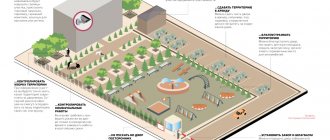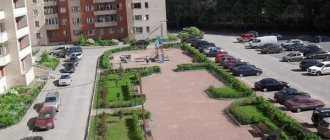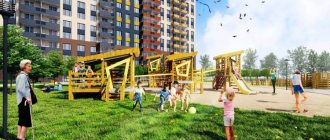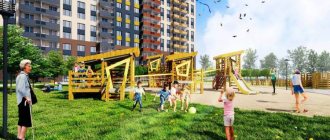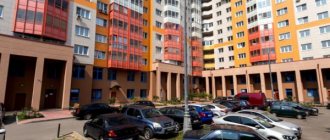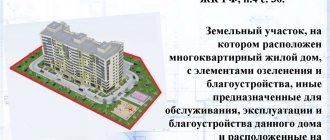Often, the owners of premises in a residential building have conflicts regarding the procedure for joint use of a common territory. As a rule, this issue is especially acute for owners of non-residential premises, as well as new residents. The yard is often closed by a barrier or gate, and all parking spaces in the local area are distributed among the “old-timers.” How to solve the problem? First of all, it is necessary to understand the mechanism of legal interaction between residents of an apartment building, as well as the procedure for using the territory adjacent to the house.
Rights to a plot near the house for residents
The owners of premises in an apartment building own the common property in the apartment building by the right of common shared ownership. This property also includes the land plot on which the house is located, with elements of landscaping and landscaping, other objects intended for maintenance, operation and improvement of the house and located on the specified land plot - this is stated in paragraph. 1, 2, Art. 36 of the Housing Code of the Russian Federation. The owners of premises in an apartment building own, use and, within the limits established by this Code and civil legislation, dispose of the common property in the house.
Direct formation of the land plot on which the apartment building is located is carried out by state authorities or local governments. From the date of the state cadastral registration of the land plot on which the apartment building and other real estate objects included in such a building are located, such land plot passes free of charge into the common shared ownership of the owners of the premises in the apartment building.
The right of common shared ownership of common property belongs to the owners of premises in the building by force of law, regardless of its registration in the Unified State Register of Rights to Real Estate and Transactions with It.
Moreover, if the land plot under the house has not been formed and state cadastral registration has not been carried out in relation to it, the land under the apartment building is owned by the corresponding public legal entity, which does not have the right to dispose of this land in the part in which it should be formed land plot for an apartment building. In turn, the owners of premises in an apartment building have the right to own and use this land plot to the extent necessary for their operation of the apartment building, as well as the objects that are part of the common property in such a building.
Thus, from the moment the land plot under the house is formed, it is presumed to be in common ownership of the owners of the premises.
But even if the land plot under the house is not formed properly, this does not prevent the owners of the premises from owning and using it within the established limits, including installing fences (subject to the appropriate procedure).
Procedure for using the local area
Possession, use and disposal of common property occurs only on the basis of a decision made at a meeting of the house. According to Art. 44 of the Housing Code of the Russian Federation, based on the results of the meeting:
- a plan for further actions related to the owned land plot can be developed. Owners have the right to determine the improvement program and decide on the construction of additional infrastructure facilities;
- Rules of use may be adopted and restrictions on the disposal of land may be established.
The use of the local area of an apartment building is predominantly discretionary in nature. It is permitted to use and dispose of owned land in any way, unless limited by law.
Not only the construction of additional facilities is allowed, but also the alienation of a land plot under various agreements. Residents can rent out the land itself, premises and other property located on it. The income received is credited to the general account and can be used according to the decision of the meeting.
According to the Rules for the maintenance of common property of an apartment building (No. 491 of August 13, 2006), the adjacent territory of an apartment building consists of:
- the plot of land where the building is erected;
- landscaping and other landscaping elements;
- children's and sports grounds;
- clothes dryers;
- collective parking lots;
- fire passages;
- transformer substations;
- heating points; other objects necessary for the normal operation of the house.
All listed objects must be located within the boundaries indicated in the cadastral passport. Owners can entrust the management of their site to: a house committee (independent management), a homeowners association or another special non-profit organization; management company.
The fate of the adjacent territory of an apartment building - the construction of children's and sports grounds, planting trees, arrangement of parking lots and installation of fencing posts - is decided only at a general meeting of home owners. The profit received is also collectively distributed. In order for the decision to be valid, half of all residents in the house must participate in the vote, proportionally for each apartment. If, after installing a fence on the site, the rights of people living in neighboring houses are violated, then, according to a court decision, an easement may be imposed on the local area. After such measures (if there is no other passage), the neighbors receive their legal right to freely move around your land.
Who gave permission to surround apartment buildings with fences? And why is it bad
While a campaign has begun in Moscow to rid the city of ridiculous fences that disfigure spaces (read about this below), some Voronezh residents have just developed a taste for fences. One can also understand when people try to restrict parking in their yards or the through passage of cars (although barriers are much better suited for such purposes). But recently, another, inexplicable trend has appeared - to close courtyards not for travel, but for the passage of other people. This is similar to village psychology - they say, since we have a house and a yard here, it means there should be a fence with a gate. And so that strangers don’t walk past!
But such “zealous owners” forget that a city is not a village, that entire institutions are engaged in organizing urban spaces all over the world. And that fences destroy the unity of urban spaces and pedestrian routes that city planners envisioned decades ago. And when such a concept appeared in the Housing Code - a local area - the city authorities could not even imagine in their wildest dreams that residents would begin to enclose these territories with fences and even fence off pedestrian sidewalks.
Komissarzhevskaya, 15b
Strangers don't come here!
This six-story house was built in 1999. For many years, along the sidewalk past the facade of this house, parents took their children to Lyceum No. 7 from the Komissarzhevskaya stop on Koltsovskaya. And along the end of the house it was possible to go along the sidewalk from the building of the regional Pension Fund administration to Komissarzhevskaya Street. This sidewalk was also used by pensioners from house No. 34 on the street. Student, and residents of other nearby houses, and hostel guests. Several years ago, the residents of house No. 15b fenced their yard with a fence, which, however, did not block the passage along these sidewalks.
“But this was not enough for our neighbors, and this summer they decided to fence off their entire local area, and it seems that they took someone else’s, blocking the once public sidewalks and putting as many as four gates with combination locks on them! The prison turned out to be in the center of the city! - Vladimir, a resident of house No. 34 on Studencheskaya Street, is indignant. “Now everyone has to go around their closed yard - every day the children splash through the mud to school and back through the yard of our house along the path, which is located just 20 meters from house 15b. But not on the sidewalk along house 15b.
And the passage to Komissarzhevskaya Street is now blocked. Pensioners from house No. 34 on Studencheskaya are looking forward to winter with horror - after all, in order to get to the pharmacy and the store, they will need to make a serious detour along slippery sidewalks.
— Why did the residents of the house on Komissarzhevskaya do this? - Vladimir continues. “Everyone, when they come across a fence, says that it’s idiotic and a “collective farm” to fence something like this in the center! And these are even the mildest definitions. And after all, the residents of house 15b did not use the fence to protect themselves from the bandits, but they want to show everyone who is boss here. Like, don’t walk past our house!
The workers of the hostel located in building 15b are also not happy with the fence. According to them, city guests are unpleasantly surprised that to enter the hotel they need to overcome gates with combination locks.
By the way, the residents of building 15b were so carried away by fence-building that they actually took over someone else’s territory with their fences. After calling “MINE!” The Central District Administration sent the Otrada HOA maintenance company an order to dismantle the metal fence by September 25, otherwise the administration promised to forcibly dismantle the fence. The specified period has passed, but the fence is still in place. And the chairman of the board of the Otrada HOA, Sergei PISKUNOV , seems ready to defend every centimeter of illegal fencing.
“Yes, we prohibited passage through our territory based on the decision of the general meeting of homeowners,” said “MOYE!” Sergey Piskunov. — The adjacent territory is the property of the residents. The passage past our house to Komissarzhevskaya Street has always been ours. We closed it because it was often used as a toilet. But I don’t see anything wrong with the fact that we went beyond our territory. We are talking about a strip of land 47 centimeters wide. If we move the fence back 47 centimeters, it is unlikely that anyone will be able to get through there. We turned to the regional department of property and land relations with a request to allow us to use this site.
However, according to residents of neighboring houses, drunken groups did not gather in this place; the sidewalk was actively used by local residents, schoolchildren, Pension Fund employees, and hotel guests. Let's see how decisively the mayor's office and the regional government are ready to defend common sense in this matter - "MY!" Will definitely be following this story.
Revolution Avenue, 9a
The gate is closed forever
There is no less interesting situation here. The 14-story building was built on the site of a vacant lot on a slope quite recently - in 2009. From the low-lying Sacco and Vanzetti street, a mountain staircase leads into the courtyard of this house.
“Until recently, having climbed these stairs, you could walk through the courtyard to the transport stop on Revolution Avenue,” says Dmitry, a resident of Arsenalnaya Street. “However, about two months ago, the entrance to the courtyard from the stairs suddenly turned out to be closed by a blank fence with a gate.
And on the side of the yard, on the gate, as we saw on site, there is an electronic lock.
“The residents decided to close this passage at a general meeting,” the chief engineer of the HOA “Revolution Avenue, 9a,” Alexander ERMAKOV, literally word for word repeated the argument of the chairman of the HOA at Komissarzhevskaya, 15b. “They painted all the entrances here.”
But who? Was it really those who used the gate? It is worth saying that from the side of Revolution Avenue the entrance to the courtyard is open. So vandals will get there anyway. But were these vandals really there? Each entrance in the house is locked with a combination lock, and it is not so easy for strangers to find out the code.
Vladimir Nevsky, 79
Each car has its own exit from the parking lot
Tens of thousands of Voronezh residents park their cars in their yards and do not realize that the car can also be... fenced off. And the first step in this direction has already been taken on Vladimir Nevsky Street, 75. There, several years ago, the Homeowners Association “Our House” decided to set up its own fenced parking lot. And not an ordinary one, but one so that each motorist has his own gate to the intra-block passage.
Judging by the documents, at first the fence even grabbed part of the sidewalk. Even the State Traffic Safety Inspectorate intervened and ordered the homeowners' association to move the fence and restore the sidewalk. But even now the fence with many gates looks strange.
Why did so many fences appear in Voronezh?
On the one hand, homeowners' associations, housing cooperatives and management companies that install fences do not violate the law - the adjacent areas are their property. But who, how and on what grounds transferred the plots to the ownership of the residents? And do they have the right to dispose of them as they please and build whatever they want there? Here's what the experts told us.
Until 2006, residential areas in Voronezh were practically not demarcated. But then the HOAs and councils of apartment buildings began to draw up the necessary documents. The boundaries of local areas were determined by the city administration. Or more precisely, the department of land relations and the department of the chief architect.
Land managers in conversation with “MY!” They said that the very concept of “house area” in the Housing Code is explained very vaguely - this is all that is needed to maintain the house. Therefore, most likely, city hall officials “drew” the local areas on the maps they had... as necessary. Then all this was legalized by a resolution of the city administration on defining the boundaries of a particular local area. With this resolution, the HOA or the council of the apartment building went to Rosreestr, where they registered ownership of the land plot. It turns out that it was the city authorities who contributed to the emergence of the problem of fences.
"MY!" addressed the mayor's office with a request addressed to the head of the city, Vadim Kstenin. In it, we, in particular, were interested in why local areas in most cases are adjacent to each other closely - without preserving space for pedestrians to pass through. The mayor's office has not yet answered this question. In an informal conversation, representatives of the city administration explained that the current department of property and land relations simply has nothing to answer. Like, it just happened that way, but no one remembers why, since the management employees were replaced.
“Fences between yards are uncivilized”
We have not yet been able to contact the former mayors of Voronezh Sergei Koliukh and Boris Skrynnikov (we eventually sent a request to Sergei Koliukh as a City Duma deputy). But it was easier to find the leaders who supervised urban planning and land relations at the mayor’s office in those years.
“We did not leave any free space between the adjacent areas so that there would be no ownerless areas,” says Vladimir ASTANIN, who worked as deputy head of the city from 2013 to 2021. — We allocated the adjacent territory to the residents so that they would be responsible for it, and not so that they would immediately begin to fence it off. Fences between yards are absolutely uncivilized. And I hope that we will live in a city without fences at every turn.
Former vice-mayor Yuri GAIDAI (worked in this position from 2000 to 2004 and from 2008 to 2012) generally repeated the thought of Vladimir Astanin, but was more emotional:
“Naturally, we did not define the boundaries of land plots so that fences could be built along these boundaries. We needed to regulate land relations. Fences are built by fools! Write it like that!
FROM THE EDITOR
“Fences are a sign of an unhealthy environment”
Authorities across the country have begun to seriously address the problems of organizing urban spaces. Last week, speaking at the Federation Council, Deputy Prime Minister of the Russian Government Vitaly Mutko said that competency centers for urban improvement will be created in all Russian regions, and by the end of the year an index of the quality of the urban environment will be approved in Russia. And the Voronezh fence initiative goes against this policy.
Provincial cities usually accept capital innovations years later. And in Moscow they are now seriously thinking about fences, which appeared here in abundance in the 1990s and early 2000s. “Proper courtyards should not be fenced with fences - signs of an unhealthy environment, but today in Moscow their number is off the charts,” the city’s chief architect, Sergei Kuznetsov, said in an interview with RIA Novosti about a month ago.
He noted that the sense of security that the fence gives is false. In his opinion, a malicious person will overcome it without any problems, and if he needs help, the fence can get in the way, so “when there is no fence and everything is visible right through, it’s much safer.”
Indeed, the functionality of the fences that fence off courtyards from pedestrians is questionable. What do they give to the residents of these houses, other than demonstrating disdain for all other residents of the city? What if suddenly all Voronezh residents decide to enclose their yards with fences? Can you imagine what city we will live in? To paraphrase the words of Professor Preobrazhensky from Bulgakov’s “Heart of a Dog,” fences are in the heads. The architect and curator of special projects at the Moscow Institute of Media, Architecture and Design “Strelka” Daria PARAMONOVA , who was contacted by “MY!” correspondents, agrees with this
“A fence is a symbol with which you tell someone: “This is mine!” says Daria. “And since we are not used to trusting laws, the symbol should be as expressive as possible. That is, the fence is not just conditional, low, but reliable. This is a psychological trick. A large number of fences in the city speaks of lack of freedom - both internal and external. If the situation changes, the fences will disappear.
Violations of the use of the local area
The most common violation associated with the improper use of local area is the restriction of the rights of other citizens.
When installing barriers or other devices restricting access, it is important to respect the rights of other citizens. There are well-known cases in which people who suffered from illegal actions went to court and received large monetary compensation, which all residents of the house are obliged to pay. The decision to install any locking device must be made at a meeting of residents (at least 2/3 voted). If the territory belongs to several apartment buildings at once, such a decision is made jointly. In some cases, part of the land is the property of municipal authorities, so you must first obtain permission from the local administration. The requirements for the barrier devices themselves are established in Order of the Ministry of Construction No. 972. In order to avoid forced demolition, these provisions must be observed.
With whom and how should the placement of fences be coordinated?
Residents must coordinate the fencing with the management company and local authorities. “There are rules for land use and development, rules for the development of the territory. Accordingly, there are architectural plans that must be followed. Therefore, a fencing project must be developed and approved at a general meeting of residents of an apartment building. Management companies can recommend design organizations that you can contact,” says Mikhailyukova.
Thus, the prepared front garden project must comply with the requirements for the installation of fences in local areas, which are established by the municipality. They may relate to the height of the fence, the dimensions of the front garden, the materials from which the fence is made, its design, the degree of transparency of the fence, etc.
Article on the topic
Front garden or front garden - which is correct?
Is it legal to restrict the rights of new owners?
The procedure for determining shares in the right of common ownership of common property in an apartment building, both for owners of residential and non-residential premises, is established by Article 37 of the Housing Code of the Russian Federation in proportion to the total area of the premises belonging to a specific owner.
According to Article 39 of the Housing Code of the Russian Federation, the owners of premises bear the burden of maintaining common property in an apartment building, the share of participation of each owner in bearing such expenses is determined by the share in the right of common ownership of the common property in such a house of the specified owner.
Thus, when determining the rights to use common property in an apartment building, the law does not make any division between the rights of persons who own residential or non-residential premises, and also does not distinguish the rights of owners depending on the duration of their ownership of real estate. Access to the local area should also be carried out taking into account the balance of interests of the owners of residential and non-residential premises.
Disadvantages of complexes with closed areas
In general, a fenced area has more advantages than disadvantages. However, this solution still creates some inconveniences for residents:
- If you have lost (forgotten) your pass, key fob, chip, code on your phone, you will no longer be able to enter the closed area;
- Your guests are forced to call the intercom at the gate, and not at the entrance or at the apartment;
- It takes much longer to wait for delivery people of goods and food, repair services (since they have to pass through more different checkpoints and issue passes);
- There are risks that an ambulance, firefighters, etc. may not arrive on time. For utility workers, a fenced area is also a headache, which is why a lot of snow and debris can accumulate in the courtyards;
- If you plan to open a cafe, bakery, beauty salon or other small business on non-residential premises in such residential complexes, you need to be prepared for the fact that not all clients will be able to get to you due to the fenced area of the complex.
In general, it should be noted that all these disadvantages, although they create inconvenience, are nevertheless offset by a large number of advantages. Living in such houses and walking around the territory becomes safer, and the surrounding area looks cleaner and more well-groomed, because people begin to treat “their” territory more carefully. The same can be said about vehicle owners. Their cars are parked among their neighbors’ cars, that is, in relative safety.
Another characteristic feature of such houses is the presence of a separate closed promenade, where you can walk with children comfortably and without fear. The territory of closed residential complexes very often becomes a “city within a city”, where there is everything for a comfortable stay for residents without going beyond its borders.
Did you find this article helpful? Please share it on social networks: Don't forget to bookmark the Nedvio website. We talk about construction, renovation, and country real estate in an interesting, useful and understandable way.
Fencing the local area of an apartment building
There are three main options for objects that can act as fencing for a local area:
- a traditional fence made of metal, stone, brick or reinforced concrete elements;
- hedge;
- barrier.
Each of these structures has its own characteristics and is designed to partially or completely prohibit travel/entry into the territory.
When erecting barriers, existing norms and regulations must be observed, primarily those related to fire safety.
To avoid claims from ordinary citizens and authorized bodies, it is necessary to comply with the legality of forming the boundaries of the local area before installing fences.
The rules provide for the following actions:
- holding a meeting of apartment building residents, during which the consent of the majority of them for the installation of enclosing structures must be obtained, a protocol with the appropriate decision must be drawn up, and a representative must be selected to contact the authorized bodies;
- submitting an application for land surveying along with the minutes of the meeting and all necessary documentation;
- performing area calculations and determining the boundaries of a land plot by authorized bodies;
- registration of the territory in Rosreestr.
After implementing all these measures, you can deal with the paperwork directly for installing the fence, which will now be absolutely legal.
The installation of such objects must be agreed with:
- Department of Architecture and Urban Planning;
- police;
- Ministry of Emergency Situations;
- ambulance.
Requirements for the appearance of fencing
According to the rules and regulations, the fence around an apartment building can have a different appearance. Features depend on what object is being fenced, for example:
- if the houses form a closed perimeter or courtyard space, border on dilapidated or emergency housing, it is allowed to install transparent fences no more than 1.6 m high, fencing elements - up to 0.75 m (solid structures are unacceptable);
- for all other types of multi-storey or mid-rise housing, it is allowed to use transparent structures no higher than 0.9 m as a fence;
- sports grounds may be fenced with transparent fences up to 2.5 m;
- fences up to 1.6 m are suitable for playgrounds;
- It is allowed to install a fence up to 2 m high around the dog walking area;
- To limit access to containers with garbage, blind or combined fences up to 1.6 m high are used, and the installation of special canopies is allowed.
The fencing of the courtyard area of an apartment building must be protected from the effects of precipitation. Most often this is done using coloring. The entire fence will have to be treated with protective paint; partial painting is unacceptable.
What is prohibited in the local area
To put it simply, there is nothing that would threaten the fire or other safety of the house, create unnecessary noise or pose any threat to the life and health of people.
For example, you cannot place industrial buildings or car washes. In some cases, apartment complex management companies set their own restrictions on any structures, activities or plantings.
Thus, in order to insure against fines and other troubles, it is better to coordinate any of your initiatives with the owners of the site. It is important to remember here that the land under the windows of an apartment building does not belong to the residents of the first floors at all, but is in common ownership, that is, this territory belongs to all owners in proportion to the share in the right to the common property. If some people need parking under the window, and others want bushes with benches and a table for dominoes, then you need to negotiate. As a rule, if the house is high, then the residents of the upper floors are not at all interested in what is under their window. The exception is parking. There are always not enough parking spaces for people. In smaller houses, people are more likely to strive to improve their areas. Conflicts can only be resolved through negotiations; there is no other way. In any case, each of the residents will ultimately have to obey the decision of the general meeting of residents or the decision of the municipality.
Advantages of a residential complex with a closed area
Living in a residential complex with a closed area and yard has many advantages:
- More free parking spaces appear . All cars enter the territory only with passes, which is why parking for cars of people who do not live in this house or are not guests of the residents is excluded. This solves not only the problem of parking congestion - the internal roads of the complex also become clearer;
- Living in residential complexes becomes safer . Of course, fencing an area does not guarantee complete safety. However, as statistics show: cases of theft and robbery in such residential complexes are much lower than in ordinary houses. In addition, cases of car theft are sharply reduced;
- It is convenient for walking and children hanging out . Thanks to the fenced territory of the residential complex, the number of transit vehicles passes is reduced to almost zero. This has a positive effect on the safety of walks for residents and their children. We also note that in residential complexes with a closed courtyard, the children's playground is visited only by the children of the residents of this house or those neighboring from this residential complex.
